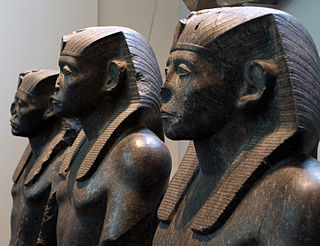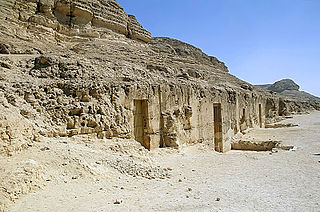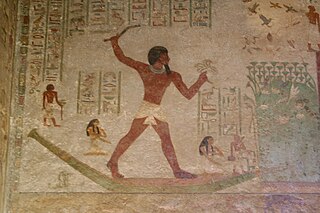The 20th century BC was a century that lasted from the year 2000 BC to 1901 BC.

Amenemhat III, also known as Amenemhet III, was a pharaoh of ancient Egypt and the sixth king of the Twelfth Dynasty of the Middle Kingdom. He was elevated to throne as co-regent by his father Senusret III, with whom he shared the throne as the active king for twenty years. During his reign, Egypt attained its cultural and economic zenith of the Middle Kingdom.

The Middle Kingdom of Egypt is the period in the history of ancient Egypt following a period of political division known as the First Intermediate Period. The Middle Kingdom lasted from approximately 2040 to 1782 BC, stretching from the reunification of Egypt under the reign of Mentuhotep II in the Eleventh Dynasty to the end of the Twelfth Dynasty. The kings of the Eleventh Dynasty ruled from Thebes and the kings of the Twelfth Dynasty ruled from el-Lisht.

The Twelfth Dynasty of ancient Egypt is a series of rulers reigning from 1991–1802 BC, at what is often considered to be the apex of the Middle Kingdom. The dynasty periodically expanded its territory from the Nile delta and valley South beyond the second cataract and East into Canaan.

Amenemhat I, also known as Amenemhet I, was a pharaoh of ancient Egypt and the first king of the Twelfth Dynasty of the Middle Kingdom.

Nubkaure Amenemhat II, also known as Amenemhet II, was the third pharaoh of the 12th Dynasty of ancient Egypt. Although he ruled for at least 35 years, his reign is rather obscure, as well as his family relationships.

Senusret I also anglicized as Sesostris I and Senwosret I, was the second pharaoh of the Twelfth Dynasty of Egypt. He ruled from 1971 BC to 1926 BC, and was one of the most powerful kings of this Dynasty. He was the son of Amenemhat I. Senusret I was known by his prenomen, Kheperkare, which means "the Ka of Re is created." He expanded the territory of Egypt allowing him to rule over an age of prosperity.

Senusret II or Sesostris II was the fourth pharaoh of the Twelfth Dynasty of Egypt. He ruled from 1897 BC to 1878 BC. His pyramid was constructed at El-Lahun. Senusret II took a great deal of interest in the Faiyum oasis region and began work on an extensive irrigation system from Bahr Yussef through to Lake Moeris through the construction of a dike at El-Lahun and the addition of a network of drainage canals. The purpose of his project was to increase the amount of cultivable land in that area. The importance of this project is emphasized by Senusret II's decision to move the royal necropolis from Dahshur to El-Lahun where he built his pyramid. This location would remain the political capital for the 12th and 13th Dynasties of Egypt. Senusret II was known by his prenomen Khakheperre, which means "The Ka of Re comes into being". The king also established the first known workers' quarter in the nearby town of Senusrethotep (Kahun).

Khakaure Senusret III was a pharaoh of Egypt. He ruled from 1878 BC to 1839 BC during a time of great power and prosperity, and was the fifth king of the Twelfth Dynasty of the Middle Kingdom. He was a great pharaoh of the Twelfth Dynasty and is considered to rule at the height of the Middle Kingdom. Consequently, he is regarded as one of the sources for the legend about Sesostris. His military campaigns gave rise to an era of peace and economic prosperity that reduced the power of regional rulers and led to a revival in craftwork, trade, and urban development. Senusret III was among the few Egyptian kings who were deified and honored with a cult during their own lifetime.

Beni Hasan is an ancient Egyptian cemetery. It is located approximately 20 kilometers (12 mi) to the south of modern-day Minya in the region known as Middle Egypt, the area between Asyut and Memphis.
This page list topics related to ancient Egypt.

Hotepibre Qemau Siharnedjheritef was an Egyptian pharaoh of the 13th Dynasty during the Second Intermediate Period.

The Abydos Dynasty is hypothesized to have been a short-lived local dynasty ruling over parts of Middle and Upper Egypt during the Second Intermediate Period in Ancient Egypt. The Abydos Dynasty would have been contemporaneous with the Fifteenth and Sixteenth Dynasties, from approximately 1650 to 1600 BC. It would have been based in or around Abydos and its royal necropolis might have been located at the foot of the Mountain of Anubis, a hill resembling a pyramid in the Abydene desert, close to a rock-cut tomb built for pharaoh Senusret III.

Sekhemraneferkhau Wepwawetemsaf was an Egyptian pharaoh during the Second Intermediate Period.

Baqet III was an ancient Egyptian official and Great Chief of the Oryx nome during the 11th Dynasty in the 21st century BCE. Apart from the position of governor of the entire nome, Baqet III also held the titles haty-a, treasurer of the king of Lower Egypt, confidential friend, true royal acquaintance, and mayor of Nekheb.

Khnumhotep II was an ancient Egyptian Great Chief of the Oryx nome during the reign of pharaohs Amenemhat II and Senusret II of the 12th Dynasty, Middle Kingdom. He is well known for his tomb at Beni Hasan and its decorations.

Khnumhotep I was an ancient Egyptian Great Chief of the Oryx nome during the reign of Pharaoh Amenemhat I of the 12th Dynasty, Middle Kingdom.

The Oryx nome was one of the 42 nomoi in ancient Egypt. The Oryx nome was the 16th nome of Upper Egypt, and was named after the scimitar oryx. It was located, approximately, in the territories surrounding the modern city of Minya in Middle Egypt.

Khety was an ancient Egyptian local governor of the Oryx nome in Middle Egypt in the Twelfth Dynasty. He is only known from his decorated tomb chapel at Beni Hasan. In the decoration of his tomb chapel appear several inscriptions providing the name and titles of Khety. He was great overlord of the entire Oryx nome. This is the main title of the local governors of the Oryx nome. Other titles include count (Haty-a), royal sealer, sole friend, king's acquaintance, who is in the chamber, who belongs to Nekhen and overlord of Nekheb, but also overseer of troops at all secret places. Not much is known about his family. His father was a person called Baqet, his wife was called Khnumhotep and there is one son attested with the name Khety. Naguib Kanawati wonders whether Khety was the son of Baqet III. The latter's tomb and those of Khety share the same plan and are close to each other.
Nakht was an ancient Egyptian local governor in Men'at Khufu in Middle Egypt in the Twelfth Dynasty. He is known from his decorated tomb chapel at Beni Hasan. The decoration of his tomb chapel is most likely unfinished. Only one wall is partly decorated with paintings, showing him standing in front of workers in the marshes. The inscriptions there provide the name and titles of Nakht. He was mayor and overseer of the eastern desert. Nakht is also mentioned in the tomb chapel of Khnumhotep II (BH3). In his chapel is a long biographical inscription reporting on the life of the governor but also on his family. There is stated that Khnumhotep I installed Nakht as governor in Men'at Khufu.


















